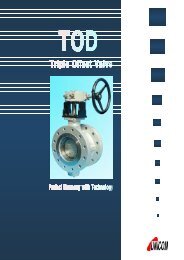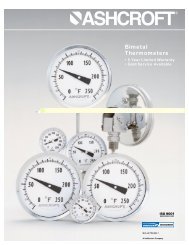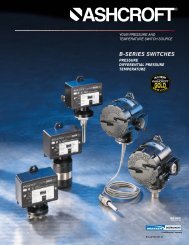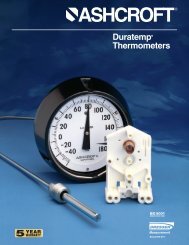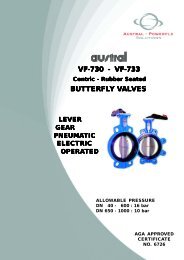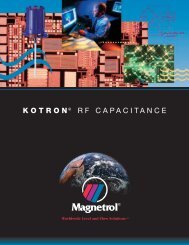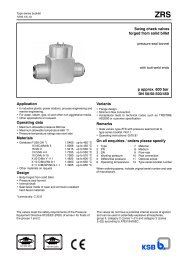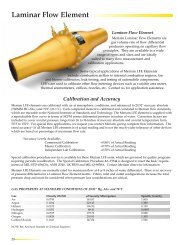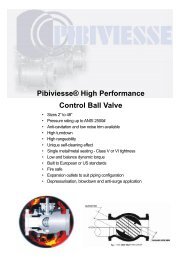maxomatic pilot operated control valves
maxomatic pilot operated control valves
maxomatic pilot operated control valves
You also want an ePaper? Increase the reach of your titles
YUMPU automatically turns print PDFs into web optimized ePapers that Google loves.
CONTROLLO DI PORTATA<br />
Le valvole <strong>pilot</strong>a tipo UBA/80 e UBA/120 ÷ 220 come pure il<br />
tipo VP possono essere adibite a <strong>control</strong>lo di pressione differenziale.<br />
In questo caso la differenza di pressione è portata alla membrana<br />
attraverso le due prese d’impulso P1 e P2.<br />
P1 collegato alla pressione maggiore (+)<br />
P2 collegato alla pressione minore (-)<br />
Se questi due valori sono le pressioni a monte e valle di un<br />
orifizio tarato, <strong>control</strong>lando tale differenza si ha un CON-<br />
TROLLO DI PORTATA.<br />
CONTROLLO DI TEMPERATURA (fig. 14)<br />
TR/S1/R Per processo di raffreddamento<br />
TR/S1/D Per processo di riscaldamento<br />
Questa valvola <strong>pilot</strong>a è utilizzata solo per il <strong>control</strong>lo di temperatura<br />
normalmente per un processo di raffreddamento.<br />
Può essere usata anche per un processo di riscaldamento<br />
purché il liquido riscaldante che passa attraverso la valvola<br />
principale abbia una temperatura che sia nei limiti d’impiego<br />
dell’elastomero (membrana). La fig. 14 rappresenta una<br />
valvola <strong>pilot</strong>a per processo di raffreddamento, normalmente<br />
chiuso, cioè l’aumento della temperatura del fluido <strong>control</strong>lato<br />
fa aprire la valvola <strong>pilot</strong>a e quindi la valvola principale. Nel<br />
caso contrario, processo di riscaldamento, l’otturatore pos. 4<br />
è montato al rovescio, valvola <strong>pilot</strong>a normalmente aperta, in<br />
tal caso l’aumento della temperatura provoca la chiusura<br />
della valvola <strong>pilot</strong>a e quindi della valvola principale. Questo<br />
sistema con <strong>pilot</strong>a è previsto per le valvole dal DN 65 e oltre.<br />
CAPACITY CONTROL<br />
Pilot type UBA/80 – UBA/120 ÷ 220 as well as type VP may<br />
be used to <strong>control</strong> a differential pressure. In this case the differential<br />
pressure comes to the diaphragm via the two pressure<br />
intake P1 and P2.<br />
P1 is connected to the higher pressure (+)<br />
P2 is connected to the lower pressure (-)<br />
If these two values are the upstream and downstream pressure<br />
of a calibrated orifice, by <strong>control</strong>ling this difference we<br />
obtain a capacity <strong>control</strong>.<br />
TEMPERATURE CONTROL (fig. 14)<br />
Type TR/S1/R for cooling systems<br />
Type TR/S2/D for heating systems<br />
This <strong>pilot</strong> is used only to <strong>control</strong> the temperature in a cooling<br />
process but may be used for heating processes with the only<br />
limit that the heating media flowing through the main valve<br />
must have a temperature lower than the elastomer limit<br />
(diaphragm). Figure 14 shows a <strong>pilot</strong> for a cooling process,<br />
normally closed. It means that the temperature increasing of<br />
the <strong>control</strong>led media tends to open the <strong>pilot</strong> valve and, as a<br />
consequence, the main valve.<br />
In the opposite case, in a heating process, the plug is assembled<br />
in the reverse position with the <strong>pilot</strong> normally open. In<br />
this case the increase of the temperature closes the <strong>pilot</strong><br />
valve and the main valve.<br />
This system with <strong>pilot</strong> is available for main valve sizes from<br />
65 mm and larger.<br />
Legenda / Legend<br />
1 Tappo per corpo valvola / Valve body cover<br />
2 Guarnizione / Gasket<br />
3 Corpo valvola / Valve body<br />
4 Tappo di regolazione / Plug<br />
5 Guida tappo regolazione / Plug guide<br />
6 Manicotto / Sleeve<br />
7 Incastellatura / Frame<br />
8 Asta soffietto / Bellow stem<br />
9 Anello regolazione molla / Spring adjusting ring<br />
10 Gruppo elemento sensibile Soffietto-bulbo-capillare /<br />
Sensitive element assembly Bellow-bulb-capillary<br />
11 Rondella / Washer<br />
12 Anello seeger / Seeger ring<br />
13 Gruppo limitatore di carico / Load limiting group<br />
14 Molla di taratura / Set spring<br />
15 Vite / Screw<br />
16 Bussola guida asta / Stem guide bushing<br />
17 Indicatore compressione molla / Spring adjusting pointer<br />
18 Dado bloccaggio incastellatura / Frame nut<br />
19 Rondella / Washer<br />
20 Spina regolazione molla / Spring adjusting pin<br />
MATERIALI<br />
Corpo in Ghisa, interni in Acciaio Inox AISI 316<br />
ATTACCHI<br />
1/2” Filettatura cilindrica UNI 338 – DIN 2999<br />
LIMITI DI APPLICAZIONE<br />
Pressione ingresso 16 bar<br />
Temperatura 150 °C<br />
14<br />
CONSTRUCTION<br />
Body in cast iron, internals in AISI 316<br />
CONNECTIONS<br />
1/2” cylindric thread UNI 338 – DIN 2999<br />
APPLICATION RANGE<br />
Inlet pressure 16 bar<br />
Temperature 150 °C



